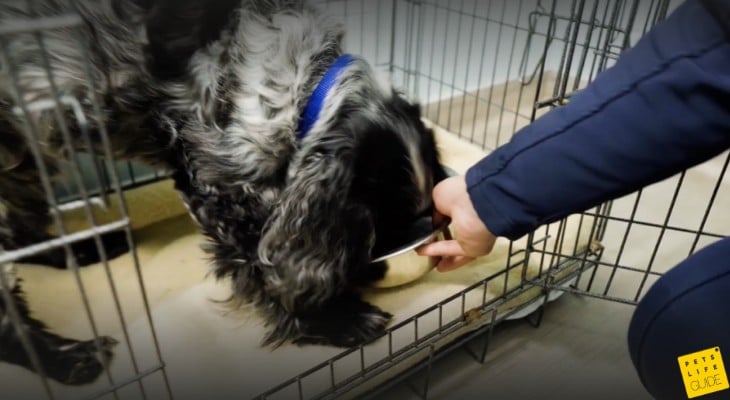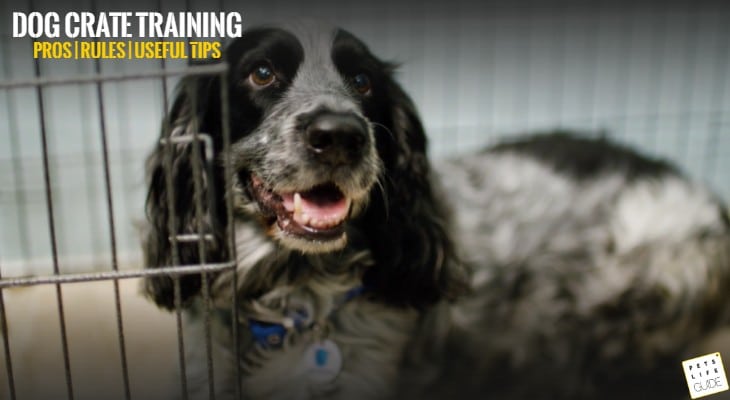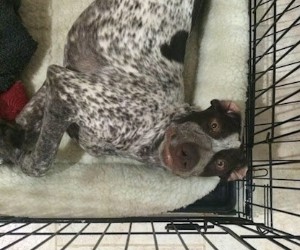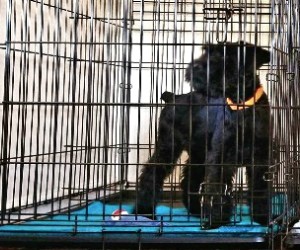Table of Contents
Conditions for Using a Dog Crate
There are a few things you should think about when using a dog crate.
- A dog crate must be considered a safe place for your dog to rest. If your dog is alone in the crate, it is a sign that he wants his rest. Children and other people must then accept this at that moment and really leave him alone.
- Never use a crate as a punishment!
- Be sure to take enough time to get your dog used to the crate so that he also understands the purpose of this place for which it is intended: peace and security.
- A dog crate can help get your pup housebroken.
- The right crate size
- Always use the cage size that is appropriate for your puppy’s breed. Keep in mind that your puppy will still need to be able to lie, stand and turn around in the dog crate when he is fully grown. Don’t buy a crate that offers too much space. Especially for large breed puppies, the dog crate is often way too big to begin with. There are different types of crates that you can use for this purpose. Discover our range of dog crates here.
Downsize Dog Kennel
Crate Divider. What is it for?
To avoid having to constantly buy a new crate as your puppy grows, you can reduce the space in the dog crate so that your puppy can still lie comfortably in it. You can do this, for example, by dividing the crate into two parts with an additional divider (usually supplied with a crate) or by placing a crate of the appropriate size. Be sure to reduce the size of the crate with something that your puppy can’t climb up on. Otherwise, there is a risk that he will hang on the wall or fall down. Only then, if the dog crate is small enough, use it to prevent your puppy from using it as a toilet as well. In this case, it is possible to use it for housetraining as well. This is because dogs, by nature, do not want to do their things in their sleeping place.
Too Big Crate Cons
If the crate is too big, you will not achieve this goal. However, this also means that you need to watch your puppy’s signals very closely and get him out of the crate when he indicates that he needs to. If you do not do this, your dog will learn that he is allowed to do his business on his bed. For this reason, it may be necessary to move the dog crate to the bedroom or hallway in the evening and at night.
The Right Place for the Dog Crate
When choosing the location for the dog crate, it is very important to find a suitable place. Place the crate in a quiet place in the living room, from where the puppy can overlook the entire room. Unsuitable locations are in front of the TV or on frequently frequented walkways in the room. You should also avoid a place by the heater or a window because of drafts and temperature fluctuations.
First Impression From the Crate
Before you introduce your dog to the crate, you should accommodate it with a particularly soft and comfortable dog bed. For this purpose, you can choose, for example, special crate pet bed or just soft dog pillow of appropriate size! In any case, it is important that the puppy can not slip or stay on the cold floor.
Let your puppy get to know the crate by regularly placing a fine treat in the crate. You can also put your puppy in it as soon as he gets tired and makes an effort to go to sleep.
The first contact with the dog crate must always be positive!
If something to eat is not interesting enough to lure your puppy into the kennel voluntarily, you can also put his favorite dog toy inside.
At this stage, the door must always remain open. If necessary, temporarily fix the door so it doesn’t accidentally slam shut when your puppy is in the crate. And: Never force your puppy to go into the crate!

Training With the Dog Crate
When your puppy easily goes into the cage by itself, the actual training with the dog cage can begin. From now on, give your puppy his food in the crate. To do this, place his dog bowl as far back in the crate as possible so that he has to go all the way through the crate to get to his food. If this doesn’t work from the start and your young dog doesn’t dare go that far in yet, place the dog bowl at the entrance. Each time you feed your puppy, the bowl will then move a little further into the cage.
Once feeding in the crate is going smoothly, you can occasionally close the door while feeding. However, open the door again immediately after your puppy is finished eating. As you go along, try to keep the door closed a little longer at a time, in about five minutes after the feeding is finished. Avoid your puppy whining before you open the door. In this case, your puppy isn’t ready yet and you’ve gone a little too fast.
You may also like
Best Dog Crates, Pet Carriers and Kennels
Teach and Treat
If the training with the food bowl is relaxed and you can easily close the door for up to five minutes, go one step further and try to teach your puppy a command to send him to the dog crate. For example, this can be the command “crate’ or “place”. Never use this command to punish your puppy. The crate must always remain a pleasant place for your dog.
Reward your puppy when he goes quietly into the kennel and you close the door for a moment. After a few moments, open the door again and reward your puppy when he stays relaxed. For example, use one of our tasty dog treats for this purpose.
Practice patiently until your puppy understands the command. As time goes on, keep the door closed a little longer and longer. Be sure to stay in the same room while doing this, though.
Leaving Puppy On His Own
If your puppy remains calm when he is in the dog crate and you close the door for an extended period of time, then start leaving the room for short periods of time. Keep extending this time period a little further and further as well. When you can leave your puppy alone for around 30 minutes, then take it a step further again and leave the house for a moment. Also practice leaving the house by extending the time outside more and more.
Don’t say goodbye too long or emotionally!
Reward your puppy when he goes quietly into the crate, then walk away. Likewise, reward him if he stays quiet when you come back and open the crate. If this all works smoothly, you will have a dog that has a positive relationship with his crate. In this way, the crate can help teach your dog to stay home alone.
Puppy Still Whining in the Crate? Now What?
Your puppy may continue to whine when he is in the crate. This may be because he feels another need at that moment, such as being hungry or needing to go to the bathroom. On the other hand, of course, it is also possible that you went too fast during the training with the dog crate. In this case, you should take a few steps back in the training.
Never Knock On the Crate!
Please do not hit or knock on the dog crate to get your puppy quiet! In the worst case, your young dog will be frightened and will associate the crate with a feeling of fear. He may even develop a fear of you, the owner, because you are the one who banged on the cage. When your puppy whines in the crate, he often does it for a reason: for example, he needs to get out to do his business, he’s hungry, he feels lonely, or he’s bored. So try to find out why your puppy is whining and act accordingly.
What to Do Before Puppy Goes Into the Crate
Before you put your puppy in the dog crate or send him inside, you should take off his collar. This is because a clumsy movement could cause him to get caught somewhere with the collar and have a traumatic experience or even suffocate.
Keep in Mind for Successful Crate Training
- Choose the appropriate size and location for the crate.
- Let your puppy get used to the dog crate slowly and gradually, and slowly extend the time spent in the crate.
- You can also use the crate for your puppy’s cleanliness training.
- Never use the dog crate as a punishment!
Good luck with your crate training!
And remember – we are here to help you with your choice. So do not hesitate to ask any questions. We will answer them.





My puppy loves to go poop in my living room even if there are pads down. How long after he eats to take him out?
Hi Darlene,
The process of digesting food is very individual. Min 30 min and max several hours or even the whole day. So, there is no direct dependence between time of eating and taking the pup out. Up to 6 months take the pup out min 3-4 times a day, the more the better. Praise him every time he poops outside.
And put pads down in the place he has chosen in the house (even if it is in the living room). Praise him every time he does it on pads too. And then slowly move pads a little, step by step every day, in the other room where you want.
This worked with my dog, and after 6 months she just stated to do everything outside.
Julia